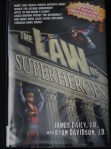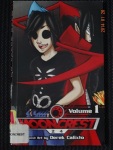Warner Library serves Tarrytown and Sleepy Hollow. Visit your public library soon and see what they have of interest.
Authors: James E. Daily and Ryan M. Davidson
Publication Information: New York, N.Y.: Gotham Books, 2012
ISBN: 978-1-59240-726-2
Library of Congress Classification: PN6790.U5
Dewey Decimal Classification: 741.5
Library of Congress Subject Headings:
Superheroes in literature
Law and literature—United States
Law—United States—Popular works
Actually, this book is not in the Warner Library but is from the Larchmont Public Library. I got this book through the Warner Library. The Warner Library, like most public libraries in Westchester County, is part of the Westchester Library System (WLS), an organization that links all the libraries together with one online catalog. This catalog allows the borrowing of materials across libraries. In this case, Larchmont was the only WLS member that had this book.
This book comes from a blog, Law and the Multiverse. I’ve never heard of the blog before this, and I learned about the book from Hamilton Book, an online bookstore that sells remainders of titles. I was intrigued and decided to see what the book was like before I bought it. I was pleasantly surprised.
Generally, law can be very dull, especially case law–at least to me. I’ve never had any interest in being a lawyer, and I’ve only really encountered court cases and legal decisions during research into different topics. Some of my research into court cases are in ancient Athens or Rome. What Daily and Davidson do is take stories out of the comic books and discuss, from a legal perspective, if what is portrayed in the story follows the law. The chapters cover: constitutional law; criminal law, evidence; criminal procedure; tort law and insurance; contracts; business law; administrative law; intellectual property; travel and immigration; international law; immortality, alter egos, and resurrection; and non-human intelligences. They draw on both Marvel and DC superheroes.
They discuss quite a few characters and stories. Is the Joker insane or not? (Conclusion: he isn’t.) The use Marvel’s Civil War event to discuss international law is interesting. With Wakanda’s king, T’Challa/Black Panther marrying Ororo Munroe/Storm and by his taking the side of anti-Registration of mutants forces in the United States would be the same as if Great Britain had taken the side of the Confederacy in the U.S. Civil War. (It would be an act of war against the sovereignty of the U.S.) Ben Grimm registers then moves to France so that he can not be used by the U.S. government; would this be possible? (Yes, and because he registered before he moved to France, Grimm did not break the law.)
Would gene patents affect Spider-Man? Superman’s talk about renouncing U.S. citizenship in Action Comics #900 is also an interesting high point. Would the law protect Wayne Enterprises from liability after Batman sets up franchises? Answer: no, but Iron Man’s franchises and funding through the Maria Stark Foundation would protect Stark Industries from liability.
If you like comic books and like to think about the plot lines and whether or not they make sense, this book is for you. It’s just a fun–and interesting–book.




